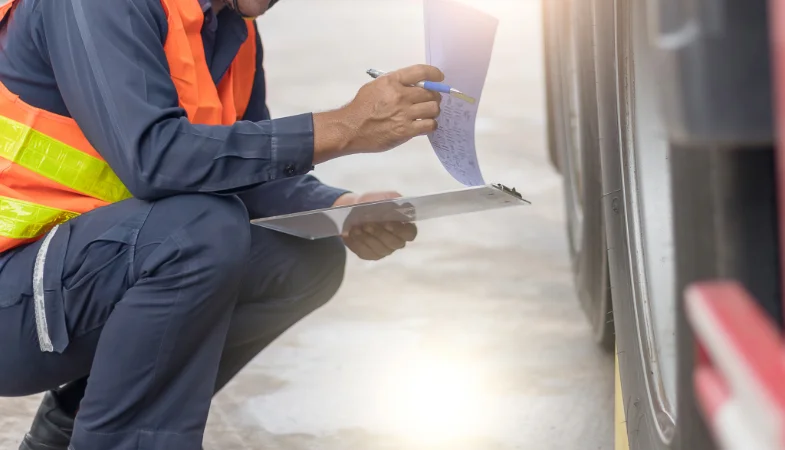Is your daily defect check solving problems or just ticking boxes?
Drivers carry out required walkaround checks before heading out on the road. But how often do those checks lead to real action? Does your system catch defects and do something about them, or are you left looking at a list of unresolved issues?
Here are the key questions every fleet or workshop manager should ask when choosing a daily defect app.
Does it go beyond reporting defects?
Your app should do more than log faults. It needs to send real-time alerts, complete with photos and timestamps, directly to your maintenance system or transport office. This allows teams to act quickly, whether that means assigning jobs, dismissing false alarms, or scheduling repairs straight away.
What happens after a defect is logged is what really keeps your vehicles roadworthy.
If an issue just sits there with no follow-up, nothing gets fixed. A proper daily defect app should trigger action:
-
Real-time alerts ensure the right people are notified immediately
-
Admin staff can review defects, rule out false alarms, or confirm genuine issues
-
Integration with your maintenance system allows faults to be dismissed, escalated, or turned into repair jobs on the spot
Without this kind of workflow, you risk delays, missed problems, unroadworthy vehicles on the road and potential non-compliance. Your defect reporting tool should feed directly into the system that runs your workshop. It is not just about logging a problem; it is about starting the process of fixing it.
Can drivers log defects anytime and anywhere?
Defects do not only appear during the morning check at the depot. They can happen mid-journey when a tyre blows, a light fails or a hose splits. That is why the best inspection apps let drivers report faults at any time, using guided checklists.
Drivers should be able to take multiple photos and add detailed notes, even when the signal is weak or offline.
Why does this matter?
Because if your system only allows pre-use checks, you are likely to miss faults that develop during the shift. A proper inspection app lets drivers log issues as they happen, with prompts that ensure the right information is recorded.
-
Photos and notes provide context to the fault
-
Offline capture makes sure nothing is lost, even with poor mobile signal
-
Real-time syncing updates the back office as soon as the app reconnects
This makes it easier to catch and resolve issues quickly, reducing the risk of roadside prohibitions or unsafe vehicles being used without anyone knowing. It keeps your inspection process live, not just a once-a-day routine.
Is compliance bulletproof?
It needs to be, because when the DVSA or a traffic commissioner gets in touch, good intentions will not cut it.
Regulators want clear, timestamped proof that checks were carried out correctly, defects were logged, and unroadworthy vehicles were not used. Without a proper audit trail, you could be looking at penalties, prohibitions or even the loss of your operator’s licence.
Your inspection app needs to go far beyond box ticking:
-
Log every check, defect and “nil” return with a date, time, user and location
-
Record who found the defect, who reviewed it, what action was taken, and when
-
Store records securely and prevent tampering
-
Keep everything for at least 15 to 18 months, ideally longer
A reliable system also lets you access reports instantly. You will not be scrambling for paperwork when an audit or roadside incident occurs. You should be able to bring up the full inspection history for any vehicle, trailer or asset in seconds.
In short, bulletproof compliance means being ready to prove everything, any time.
Does it support all your vehicle types?
It should, because most fleets are not made up of just one type of vehicle.
Whether you operate HGVs, vans, plant, trailers or a mix of them all, your inspection app needs to handle that variety. A tipper working in a quarry has different requirements from a box van doing trunking work. The same goes for plant machinery under LOLER or trailers subject to ADR rules.
Your system should allow you to:
-
Create specific checklists for each vehicle type, with relevant items
-
Use DVSA-approved templates as a base and customise them as needed
-
Include fields for things like tyre pressure, hydraulic lines or body condition
-
Apply different inspection schedules depending on how the asset is used
This flexibility ensures your cheques are relevant and thorough. It also prevents drivers from wasting time on irrelevant items or missing important ones.
For mixed fleets, a one-size-fits-all solution does not work. Your inspection system needs to reflect the real variety and risk levels in your operation.
What does the back office dashboard do?
An app on its own is not enough. If you do not have a proper admin dashboard behind it, you are just collecting data without doing anything useful with it.
The real power of a defect system lies in what happens behind the scenes. The back office is where data becomes action. Fleet managers, workshop teams and admin staff need to be able to:
-
Review defects, dismiss false ones or escalate the real issues
-
Create and assign repair jobs linked to technicians or external workshops
-
Track unresolved defects, with clear visibility of who is doing what
-
Generate digital job cards technicians can access and update in real time
-
Analyse trends across vehicles, drivers or types of defect
-
Monitor compliance indicators like nil-return rates and overdue inspections
-
Filter information by depot, fleet or customer, useful for in-house and third-party work
With a dashboard like this, you are not chasing paperwork or wondering if something has been fixed. You are tracking every issue from the moment it is reported right through to sign-off.
Without this, a defect is just a red flag on a phone. With it, you have a full loop that keeps vehicles safe, staff accountable, and compliance solid.
What makes it practical to use?
Drivers are busy. If your defect app is not simple and quick, it will not get used properly or at all.
A practical app should feel straightforward from the moment a driver opens it. Look for features like:
-
Easy login, ideally connected to the driver’s mobile
-
One-tap vehicle selection with no long scrolling lists
-
Guided, mandatory checklists that follow a logical order
-
Pre-set defect options to speed up entries and standardise reports
-
Free-text fields for extra detail when needed
-
Fast photo and video capture so drivers can show exactly what is wrong
-
Live photo enforcement so drivers must take a fresh picture, not one from the camera roll
All of these features reduce friction. That makes reporting quicker, easier and more accurate. If logging a defect feels clunky, drivers are more likely to put it off or avoid it. But if the process is fast and clear, they are much more likely to report issues as they happen.
And that leads to better data, stronger compliance, and fewer surprises. Practicality is not just about making life easier; it is what makes your defect system reliable and usable every day.
What are the key takeaways?
-
Save time by cutting out paperwork, enabling instant reports and creating jobs straight away
-
Stay compliant with a strong audit trail, DVSA-ready checks and secure records
-
Reduce downtime through faster alerts and quicker repairs
-
Improve safety by spotting patterns in defects or driver behaviour
-
Lower admin costs with digital storage, automatic reporting and better insights
The bottom line?
A proper daily defect app does more than just record faults. It connects people, sends alerts, and drives the repair process. If your current solution does not link drivers to workshops with clear dashboards and compliance logs, then you may as well still be using paper.





